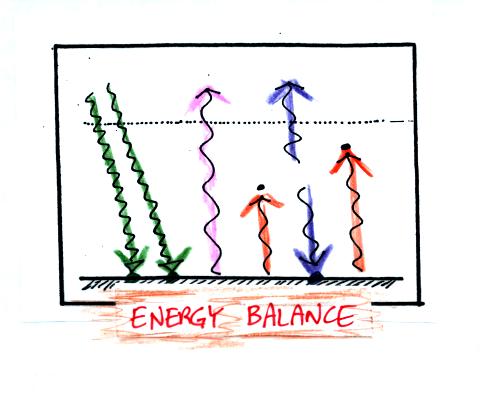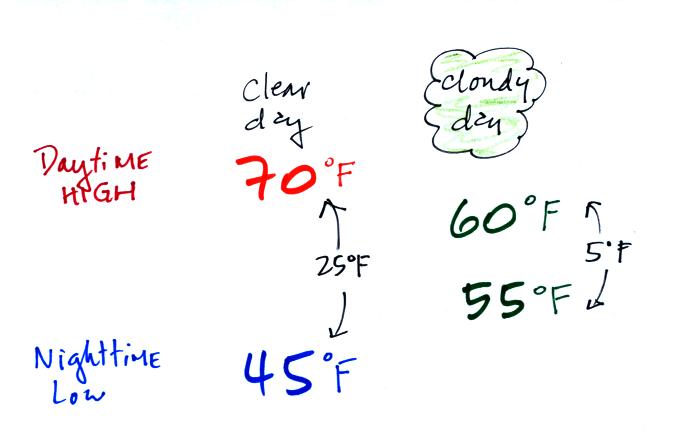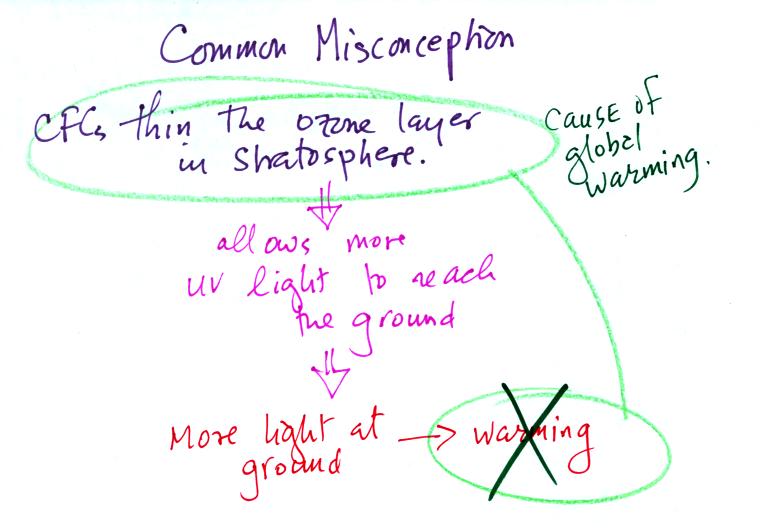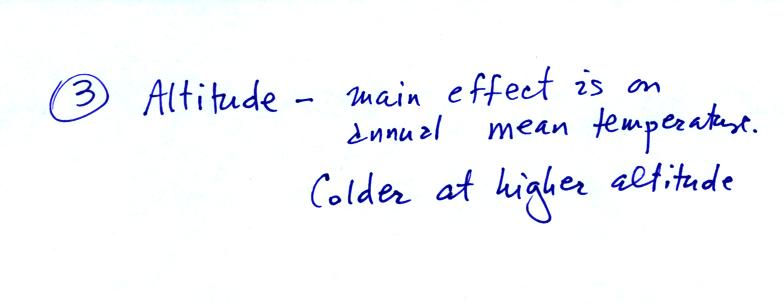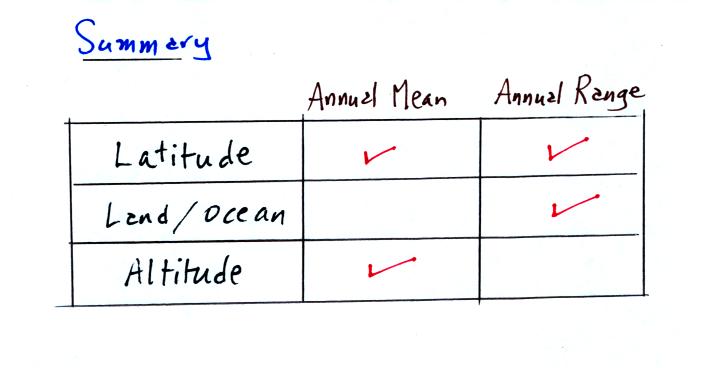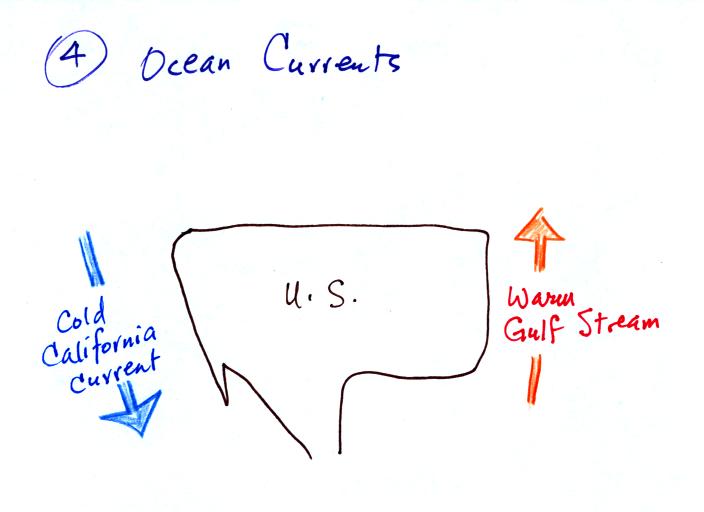Tuesday Oct. 12, 2010
3 songs from Jackson Browne before class today ("Lives in the Balance",
"Sky Blue and Black",
and
"The
Barricades of Heaven").
The Upper Level Charts Assignment has been graded. This
material will NOT be on this week's quiz.
The In-class Optional Assignment from last Thursday has also been
graded. This IS something you should review for the quiz. Here are
answers to the questions.
The 1S1P Assignment #1 reports should be graded by
Thursday.
Expt. #3 materials should be available before the quiz on
Thursday.
Today's pictures
and
videos
of
the
day were taken during and after some pretty nasty
weather
earlier last week in Pheonix (Tuesday) and in the
Flagstaff area (Wednesday).
The hail and the tornadoes were caused by supercell
thunderstorms. An air mass thunderstorm and a supercell are
sketched below (we'll cover this material in more detail near the end
of the semester)
A supercell thunderstorm has a tilted rotating updraft (updrafts
are vertical in air mass thunderstorms). Hail can form in clouds
like this because the growing hailstone can be cycled up and down
inside the cloud many times which allows it to grow larger. A
wall cloud is a distinctive feature found at the base of a rotating
updraft (mesocyclone).
The Fujita
Scale (see also the Enhanced
Fujita Scale) is used to rate tornado intensity. The scale
runs from F0 - F5 though there have been a few tornadoes that might
have reached F6 strength (winds greater than 300 MPH). Some of
the damage in the photographs above seem typical of F1 damage.
We're almost done with energy balance and the atmospheric
greenhouse effect. We must first try to use the simplified
representation of the greenhouse
effect to understand the effects of clouds on daytime high and
nighttime low temperatures.
Here's the simplified picture of
radiative equilibrium (something
you're probably getting pretty tired of seeing). The
two pictures below show what happens at night
when you remove
the
two green rays of incoming sunlight.
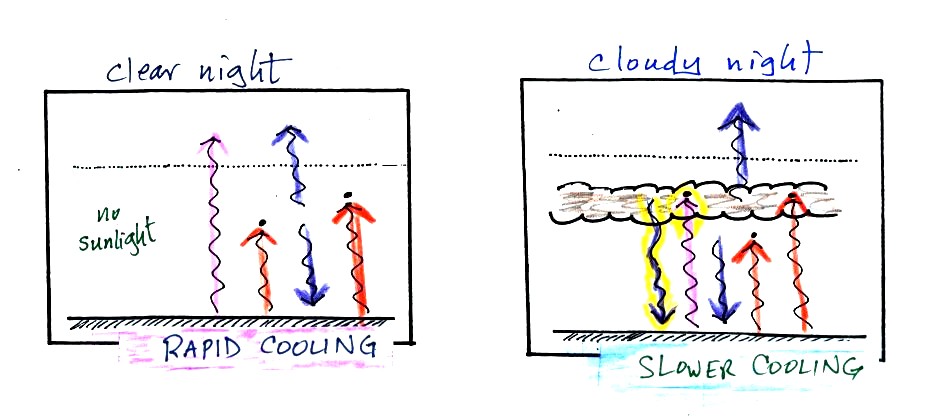
The picture on the left shows a
clear night. The ground is losing
3
arrows of energy and getting one back from the atmosphere. That's
a
net loss of 2 arrows. The ground cools rapidly and gets cold
during
the night.
A cloudy night is shown at right. Notice the effect of the
clouds.
Clouds are good absorbers
of infrared
radiation. If we could see IR light,
clouds would appear black, very different from what we are used
to (because clouds also emit IR light, if we could see IR light the
clouds might also
glow). Now none of
the IR radiation emitted by the ground passes through the atmosphere
into space. It is all absorbed either by greenhouse gases or by
the
clouds. Because the clouds and atmosphere are now absorbing 3
units of
radiation they must emit 3 units: 1 goes upward into space, the other 2
downward to the ground. There is now a net loss at the ground of
only
1 arrow.
The ground won't cool as quickly and won't get as cold on a cloudy
night as it does on a clear night. That makes for nice early
morning bicycle rides this time of the year.
The next two figures compare clear and cloudy days.

Clouds are good reflectors
of visible
light. The effect of this is to
reduce the amount of sunlight energy reaching the ground in the right
picture. With less sunlight being absorbed at the ground, the
ground
doesn't need to get as warm to be in energy balance.
It is generally cooler during the day on a cloudy day than on a
clear
day.
Clouds raise the nighttime minimum temperature and lower the
daytime
maximum temperature. Here are some typical daytime high and
nighttime
low temperature values on clear and cloudy days for this time of the
year.
We'll use
our simplified representation of radiative equilibrium to clear up a
common misunderstanding concerning the cause of global warming.
Many people have heard that
chlorofluorocarbons are destroying stratospheric ozone and allowing
more UV light to reach the ground. It seems reasonable that this
increase in energy reaching the ground would warm the
earth. More energy does reach the ground but it is not
enough to cause signficant warming. Thinning of the ozone layer
IS NOT the cause of global warming.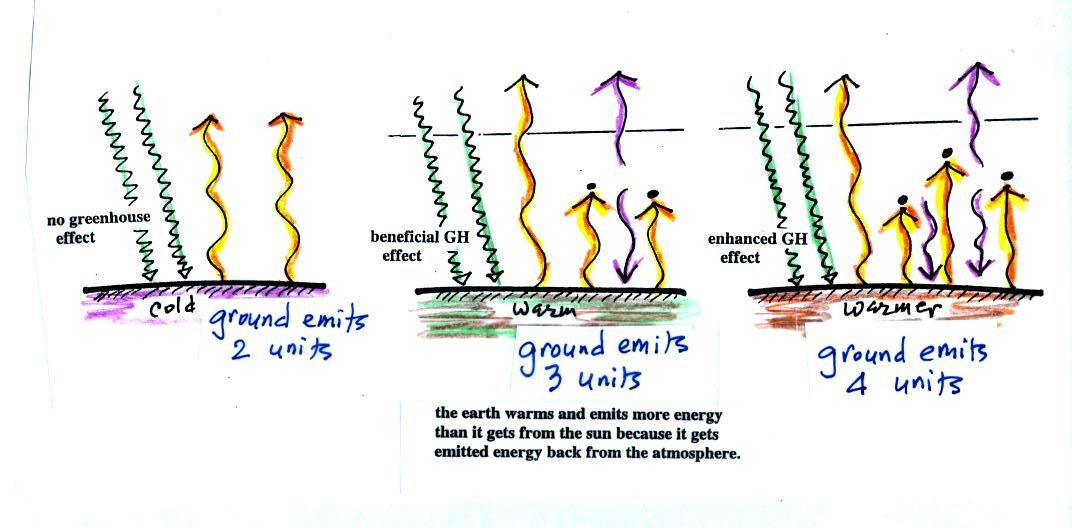
Enhancement of the greenhouse
effect is what might cause global warming.
The figure (p. 72c in the
photocopied Class Notes) on the
left
shows
energy balance on the earth
without
an atmosphere (or with an atmosphere that doesn't contain greenhouse
gases). The ground achieves energy balance by emitting only 2
units of energy to balance out what it is getting from the sun.
The ground wouldn't need to be
very warm to do this.
If you add an atmosphere and greenhouse gases, the atmosphere will
begin to absorb some of the outgoing IR radiation. The atmosphere
will also begin to emit IR radiation, upward into space and downard
toward the ground. After a period of adjustment you end up with a
new energy balance. The ground is warmer and is now emitting 3
units of energy even though it is only getting 2 units from the
sun. It can do this because it gets a unit of energy from the
atmosphere.
In the right figure the concentration of greenhouse gases has
increased
even more (due to human activities). The earth would find a new
energy balance. In this case the ground would be warmer and would
be emitting 4 units of energy, but still only getting 2 units from the
sun. With more greenhouse gases, the atmosphere is now able to
absorb 3
units of the IR emitted by the ground. The atmosphere sends 2
back to the ground and 1 up into space.
The next figure shows the erroneous cause of
global
warming.

Now an entirely
new topic. Read carefully through these notes, you'll find a link
to an Optional Assignment that is due next Thursday, Oct. 21.
How would you describe Tucson's climate? Hot and
dry?
You're basically conveying information about temperature and
precipitation. Here we'll just concern ourselves with
temperature. It does get pretty hot in Tucson in the
summer. But it doesn't stay hot all year. With just two
numbers, the annual mean or annual average temperature and the annual
range of temperature you can give someone a pretty complete idea of the
temperature in Tucson and how it changes during the year. More
detailed statistics for Tucson are available at this Tucson climate data
link (this link contains some details concerning Tucson climate that weren't covered in
class).
There are three or four main factors that determine a region's annual
mean and annual temperature range.
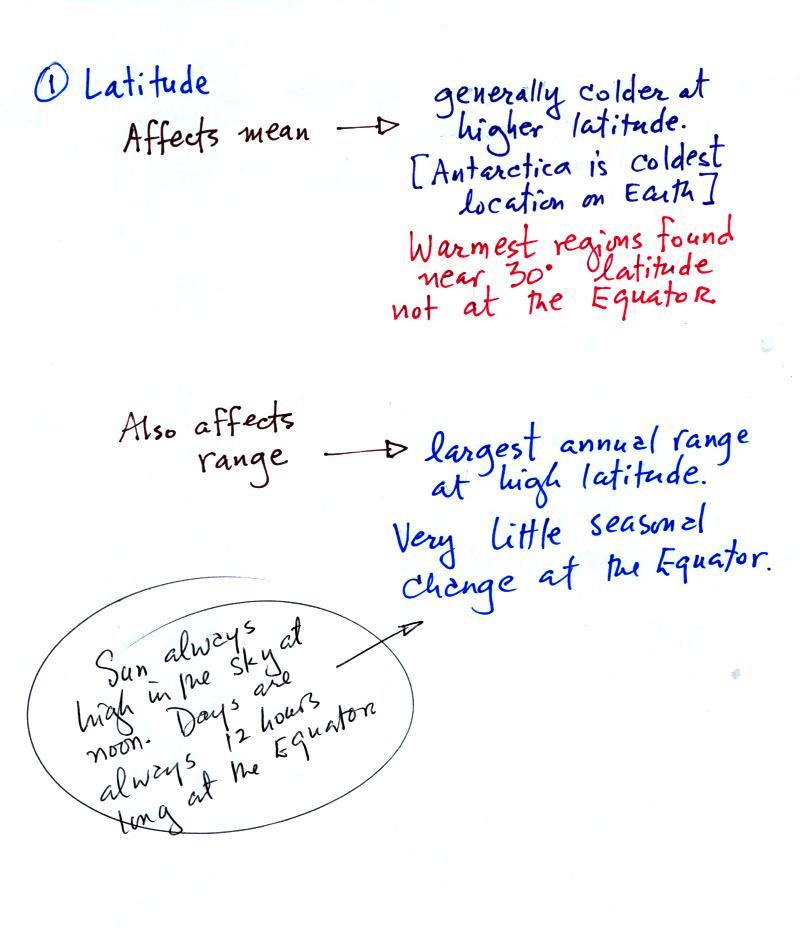
Latitude affects both the annual mean and the annual range of
temperature. The polar regions have colder annual average
temperatures than any other location on earth. As we'll see, some
of the other
controls of temperature work together with high latitude to make
Antarctica and the South Pole colder than the North Pole. The
hottest regions on earth are found near 30 latitude, not at the Equator
(you'll find some discussion of this on pps. 79 and 80 in the
photocopied ClassNotes which wasn't discussed in
class)
The annual range of temperature increases with increasing
latitude. There is little or no seasonal change at the Equator.

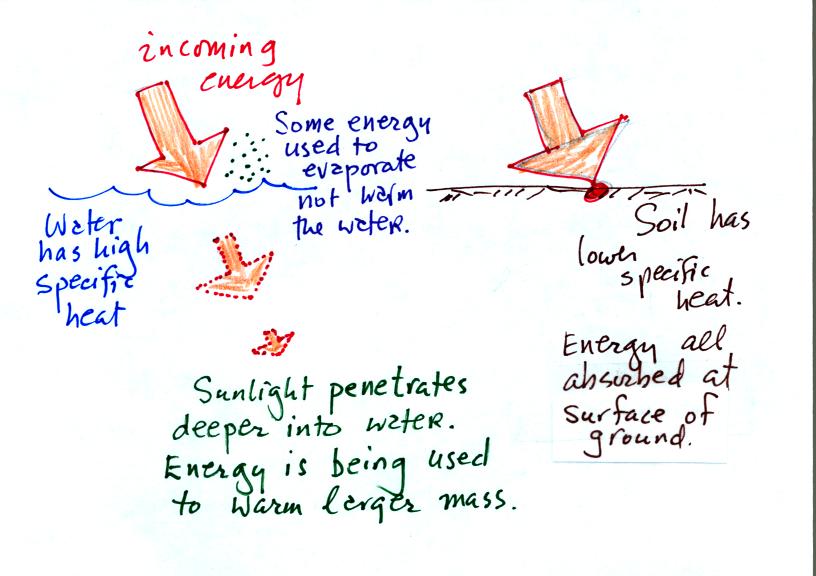
Here is a
link to
an
Optional Assignment
that you can download and print. The assignment will be due at
(or before) the start of class on Wednesday Oct. 20.
The table below summarizes the three controls of
temperature that we
have covered so far. One of them affects both the annual mean and
annual range, one affects just the mean, and the other just the annual
range.
One final factor:
Cities on the west coast and east coast of the US can
have very
different climates even if they are at the same latitude and
altitude. A cold southward flowing ocean current is found along
the West
Coast. The warm Gulf Stream current flows northward along the
East Coast. Winds at middle latitudes generally blow from west to
east. The city on the West Coast will feel the full moderating
effect of the ocean. The city on the East Coast will be affected
by the Atlantic Ocean but also by winds blowing across the interior of
the US.

What kind of climate would you expect to find at Point X near the Equator
in the middle of
the Pacific Ocean? I tried to answer that question in
class. The answer
to the question included a short story that featured such things as
carved wooden pigs, tropical island
beverages, maybe a bit of romance (or lack of), and something called
betelnut.
I spend most of the remainder of today's
class telling you
about an awesome field experiment that I took part in several years
ago. What is the tie in with this class? A good part of the
experiment was conducted at a relatively small island near the equator
in the middle of the Pacific Ocean. Now that we have learned
about some of the factors that control/determine a region's climate you
should understand that
there is very little change from summer to winter in regions like this.

The photograph above appeared on the cover of the April 1994
issue of
the Bulletin of the American Meteorological Society. If you look
closely you might recognize one of the two bald men in the photo (he
had been given the
nickname "Wilbur" by one of the members of the group, the other bald
man's name was Orville). This photo was taken on Kapingamarangi
Atoll (shown on the map below, see pps 81 & 82 in the photocopied
ClassNotes), shortly before all the men were about
to board ship and leave Kapingamarangi. The two women (Erica at
left, Maureen in the middle) were going to remain behind and operate
all of the research equipment. The scene looks happy enough, but
"Wilbur" revealed that he had taken a liking to one of the two women
and was anything but happy.
What we were doing on Kapingamarangi? We were a small
part of a much larger field experiment. Wilbur and Orville's job
was to install the tall white lightning detector at the left edge of
the photograph. They would later travel to Rabaul (on New Britain
island) and Kavieng (New Ireland island) in Papua New Guinea and
install
two more detectors. Papua New Guinea would turn out to be a very
different place. Until recently some of the highland tribes there
practiced cannibalism and shrunk heads. You can also get
malaria in Papua
New
Guinea.
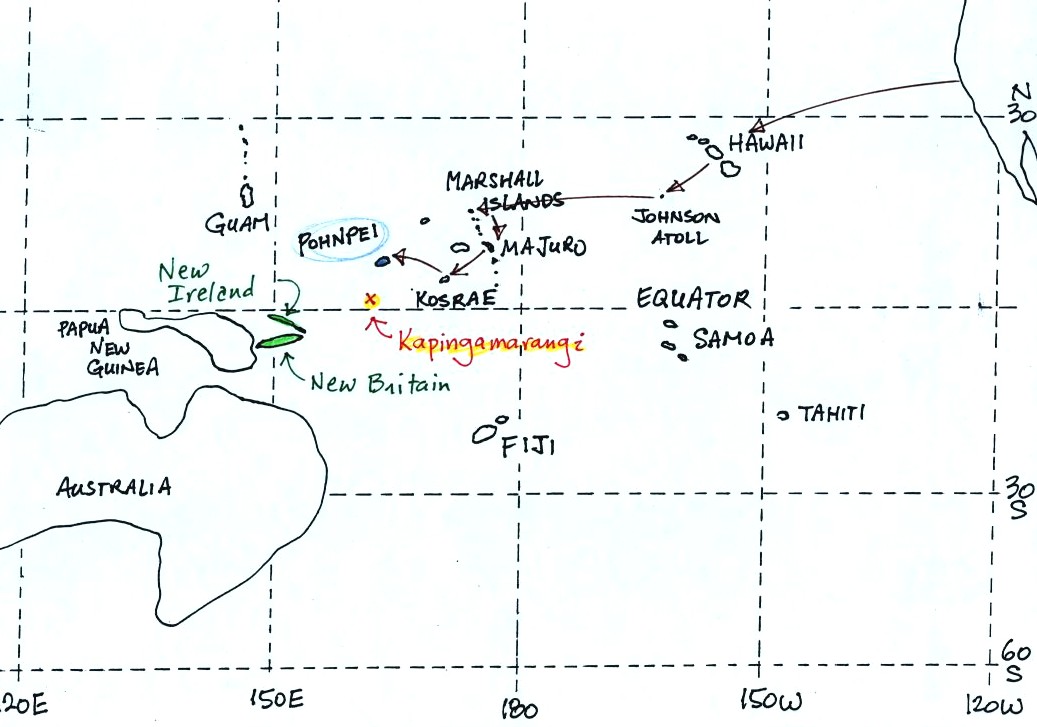
To get to Kapingamarangi you first need to fly to Pohnpei (an
island in
the Federated States of Micronesia). The route is shown
above. Then you take a cargo ship for about a 4 day sail to
Kapingamarangi. We had intended to fly to Pohnpei, set sail for
Kapinga the next day, and then spend about a month on
Kapingamarangi. The ship however was delayed 3 weeks. That
gave us plenty of time to visit the island of Pohnpei but ultimately
meant we could only spend a few days on Kapingamarangi.
Pohnpei is a fairly large island and, together with some of
the
other Micronesian islands, is a popular, world-class, snorkeling and
scuba
diving destination. Pohnpei also has a weather station that
is
operated by the US National Atmospheric and Oceanic Administration
(NOAA).
Pohnpei
is located at low latitude in the middle of the Pacific
Ocean. Both of those factors will reduce the annual range of
temperature. How
large
do
you think the annual range is?
The following precipitation data show that Pohnpei is also one of
the
rainiest locations on earth
Close to 400 inches of rain may fall in the interior of
Pohnpei. The rainiest location on earth is in Hawaii with about
460 inches of
rain per year. (Kolonia is the largest town on the island of
Pohnpei)
Pigs
are also an important part of daily life on Pohnpei, Kapingamarangi,
and the other islands in Micronesia.
The Micro Glory (shown below) sails back and forth between
Pohnpei
and Kapingamarangi about once a month. The ship carries supplies
to the people on Kapingamarangi and some other small islands.
They pay for the supplies with
pigs (the pigs are sold on Pohnpei). We shared deck space on the
Micro Glory on the trip back to Pohnpei with 20 to 30 pigs (they were
hoisted aboard in nets)
Most of the lower deck in the photo above (under the
hoists)
was occupied by pigs on the return trip. One of the pigs died on
the return trip - that was a very serious matter.
We also had a chance to sample some of the local beverages.
Drinking sakau (as it is called on Pohnpei) turns your mouth and
throat numb. It is supposed to relax you, make you sleep more
fully, and doesn't seem to have any after effects. Until fairly
recently
you could buy kava in pill form at local supermarkets. However,
because of reports that it can cause serious liver problems, that is no
longer the case. There are no reports of liver problems when
drinking kava that has been prepared in the traditional way. Here is a link to a
Wikipedia article on kava.
We never tried betelnut. Areca nuts are wrapped in betel
leaves
and chewed together with lime (lime is pretty caustic, that is one of
the reasons I didn't try betelnut). The resulting mixture is a
mild
stimulant (some people add tobacco to the mix). The most
interesting aspect, however, is that chewing betelnut colors your mouth
and teeth
bright red.
You
don't
swallow
betelnut,
you
spit it out. You see the bright red stains
on sidewalks and the ground wherever you go. Most hotels will
also have a large sign near the entrance reminding guests not to chew
betelnut inside the hotel. You can read more about betelnut here.


